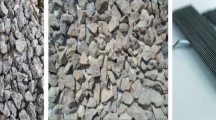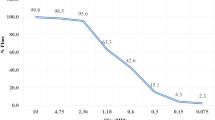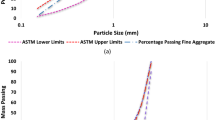Abstract
Construction industry consumes a large amount of natural resources and energy and produces a large quantity of waste. One of the solutions to reduce its negative effects is recycling wastes to produce environment-friendly materials. This paper presents an experimental investigation on the effect of treated recycled waste tires steel fibers on fresh and mechanical properties of self-compacting concrete made with recycled aggregates and granulated glass blast furnace slag as a substitution to cement by weight. The results showed that the addition of either recycled aggregates or recycled steel fibers reduces the rheological properties by decreasing the slump flow and increasing the V-funnel time. The reduction in rheological properties could be partially mitigated by the substitution of cement by 15 and 25% of GGBFS. The TRSF enhances the compressive and flexural strengths and the elastic modulus and reduces the total shrinkage.
Graphical Abstract

Similar content being viewed by others
Explore related subjects
Discover the latest articles, news and stories from top researchers in related subjects.Avoid common mistakes on your manuscript.
Introduction
The population growth in the world is accelerating the need for infrastructure and construction materials, such as concrete. Recycling waste materials such as concrete from construction and demolition waste could be an alternative to natural aggregates (NA) in concrete to save a significant amount of energy, reduce the amount of CO2, and decrease the need for landfilling spaces [1]. However, recycled concrete aggregates (RA) have a negative effect on the fresh and hardened properties of concrete because of the high proportion of adhered old mortar on their surfaces which has a higher water absorption [1]. To mitigate the negative effect of RA on the workability of concrete, cement replacement materials such as granulated glass blast furnace slag (GGBFS) and fly ash which are known to enhance the workability could be used in combination with fibers. Recycled steel fibers (RSF) recovered from waste tires could replace industrial steel fibers (ISF) with comparable mechanical properties, lower cost, and less CO2 emission [2]. A reduction in workability, an increase in compressive and flexural strengths when up to 1.5% by volume of untreated RSF were used have been reported [2,3,4]. GGBFS generated as waste in steel factories improves the workability of concrete and its compressive strength and durability at long term [1, 5,6,7]. Only few studies investigated the combined effect of treated RSF and RA on the properties of SCC. This paper tries to fill this gap using an environment-friendly concrete combining RA, treated RSF, and GGBFS from the waste of a local steel factory. The rheological properties at the fresh state as well as the compressive and flexural strengths as well as the elastic modulus and the microstructure are investigated.
Materials and methods
Material used
The cement used in all the mixtures of SCC was CEM II-B/42.5, with a fineness of 390 m2/kg and a density of 3050 kg/m3. A local GGBFS with a specific gravity of 2800 kg/m3 and a fineness of 430 m2/g was used as cement replacement by weight. Fine NA have a specific gravity of 2.65, a fineness modulus of 2.24, and a water absorption coefficient of 1.34. Two granular classes of 3/8 and 8/15 for coarse NA were used. Their specific gravity and water absorption were 2.53 and 1%, respectively. RA were obtained from crushed manufactured concrete slab made of a 30-MPa concrete. Fine RA (0/5) had a fineness modulus of 2.83, a specific gravity of 2280 kg/m3, and water absorption of 8.5%. The specific gravity of coarse RA was 2350 and 2370 kg/m3 for class 3/8 and 8/15 and their water absorption coefficients were of 4.28% and 3.28%, respectively. RSF were obtained from grinding the end-of-life used tires and were treated by cleaning and separating them from the rubber residue particles before their incorporation in concrete mixtures. The fibers varied from 0.1 to 0.4 mm in diameter and 5 to 45 mm in length. Their average tensile strength and elastic modulus were about 2000 MPa and 190 GPa, respectively.
Mixes used and tests
Water-to-cement ratio of 0.4 and super-plasticizer content of 1.15% (by weight of cement) were constant in all mixtures. In addition to the reference mixtures with NA (SCC-N) and recycled mixture with 25% and 50% of fine and coarse RA (RSCC), respectively, six other mixtures with 0.3, 0.5, and 0.8% of fibers (TRSF) alone or with 15% and 25% of GGBFS were prepared. At the fresh state, slump flow diameter and T50 time were measured to determine fluidity and estimate potential viscosity, the V-funnel time was used to determine the filling capacity, whereas the segregation resistance was evaluated by the sieve test. The 28-day compressive strength was measured on cubes 100 × 100 × 100 mm. The three-point flexural strength of SCC was determined on prismatic specimens, whereas the modulus of elasticity was measured on cylindrical specimens. The total shrinkage was evaluated on prismatic samples of dimensions 70 × 70 × 285 mm for 180 days.
Results and discussion
The results of the different SCC mixtures investigated in the present study at fresh and hardened state are shown in Table 1.
Fresh properties
Slump flow diameter and time
The substitution of NA by RA decreases the slump flow diameter from 760 to 750 mm and increases T50 from 1 to 1.6 s (Table 1). The incorporation of RA leads to higher water absorption due to their porous nature and rough texture. The presence of the adhered mortar leads to more pores which can not only absorb and reduce the amount of water but also reduce the workability [1]. In addition, the increase of (TRSF) decreases both T50 and the slump flow diameter. The mortar covers the surface of the fibers and since the steel fibers have a large surface area, fibers require more paste and then the friction increases between them and the aggregates due to insufficient fluid phase for the lubrication. In addition, the non-uniform fiber geometry can increase the contact network between the fibers and the matrix, which leads to a reduction in the workability of the concrete. The increase of GGBFS content with lower density than cement increases the volume of the paste and slightly increases the slump flow diameter and reduces T50 with no segregation.
V-funnel flow time
The substitution of NA increases the flow time Tv from 3.73 to 4.32 s. This increase might be due to the high-water absorption capacity of RA because of their high fines content compared to NA. The incorporation of fibers increases the Tv flow time with no sign of blockage. The mixture 15RSCC0.8 presents the longest flow times of 7.1 s. This is due the formation of a fiber cement matrix network which is proportional to the percentage of fibers [3]. However, increasing GGBFS content from 15 to 25% as cement replacement decreases the flow time.
Segregation
The presence of RA in the SCC leads to an improvement in the segregation resistance of 15.18% compared to SCC-N. This could be attributed to the high-water absorption coefficients of RA compared to those of NA and the porous and rough texture of the adhered mortar. The increase of fibers content from 0.3% to 0.8% increased the segregation resistance from 19 to 24%. This improvement is due to the increase in internal friction between the fibers and the aggregates. A slight increase in the segregation resistance of the RSCC was also noticed with 15% substitution of cement by GGBFS.
Mechanical properties
Compressive and flexural strengths
The 28 days compressive and the flexural strengths decrease up to 7.95% and 22.88%, respectively, with the substitution of NA by RA. The RA are weaker than natural aggregates because the impact force during the crushing process creates potential cracks. In addition, the Interfacial Transition Zone (ITZ) between the old mortar and the RA is weaker than the new ITZ between new and old mortar. The old ITZ could be the first area where the cracks develop. The addition of TRSF has a positive effect and it can compensate the drop in strength. The compressive strength increases with the addition of up to 0.5% of fibers and then it decreases slightly when 0.8% fibers was added. The use of 15% GGBFS combined with 0.3%, 0.5%, and 0.8% of TRSF increases the compressive strength compared with RSCC by 6.17%, 11.11%, and 8.14%, respectively. This increase could be due to the incorporation of fibers and their ability to delay the formation and propagation of cracks in concrete, which improve the stress distribution and load transfer in concrete [2]. The addition of 0.3 to 0.8% of TRSF increases the flexural strength compared to RSCC by 20.81 to 31.58%, respectively. This increase could be attributed to the random distribution of steel fibers in the SCC, which helps to transfer the fracture loads from one point to another [3].
Elastic modulus
The substitution of NA by RA leads to a decrease of 13.50% in the elastic modulus of the SCC. This is mainly due to the high porosity and the volume of mortar attached to RA compared to NA which leads to a less dense concrete. In addition, the existence of micro-cracks inside the RA which forms during the crushing process of concrete waste and the ITZ decrease the rigidity of RA and hence decrease their elastic modulus [8]. The addition of TRSF increases the elastic modulus of SCC compared to RSCC by 5.30%, 12.94%, and 9.73% at the age of 28 days when adding 0.3%, 0.5%, and 0.8% TRSF, respectively. This could be due to the bridging effect of the TRSF, which resulted in better integration, greater rigidity of the concrete, and better ability to resist the applied force. In addition, the TRSF distribute the stresses on the RSCC sample, which reduces the longitudinal deformation and the shape of the TRSF could improve the binding and anchoring of the fibers in the concrete [9].
Total shrinkage
Figure 1 reveals that the total shrinkage increases up to 47% with the increase of the RA content. A positive effect of the incorporation of TRSF is clearly noticed on shrinkage of SCC mixtures. The synergistic effect of TRSF and GGBFS could mitigate the unfavorable effects on shrinkage caused by the RA. The mixture 15RSCC0.8 presents a reduction of 30.20%, compared to the mixture RSCC as the steel fibers limit the dispersion and propagation of cracks, reduce the movement of the skeleton and evolution of the microstructure, and hence reduce the negative effect of RA on shrinkage [3, 10, 11].
Microstructure analysis
A very good bond between the fibers and the cement paste can be observed in (Fig. 2a, b). The surfaces of the TRSF are covered with the dense and hydrated cement paste and the fiber–matrix interface is homogeneous. This not only limits the occurrence of cracks but also plays an important role in bridging cracks, thereby improving the strength and toughness of the concrete matrix and decreasing shrinkage. The TRSF surfaces did not show residual impurities of rubber which could hinder the bond between the TRSF and the concrete matrix Fig. 2c. Furthermore, Fig. 2d shows a rough imprint of the steel fiber which was removed indicating a good bond between the TRSF and the matrix.
Conclusion
This experimental investigation has shown that the workability of fresh SCC decreases with the increase of RA content and the fibers volume fraction but the substitution of cement by GGBFS improves the workability. The use and increase in the content of RA and TRSF have a positive influence on the resistance to segregation of SCC. The use of RA decreases the mechanical properties of the SCC but the addition of TRSF reduces this loss of strength. The substitution of NA by RA led to an increase in the total shrinkage deformation, while the incorporation of both TRSF and GGBFS in SCC mixtures decreases the total shrinkage deformation and hence the risk of cracking.
Data availability
Data are available upon reasonable request.
References
O.K. Djelloul, B. Menadi, G. Wardeh, S. Kenai, Performance of self-compacting concrete made with coarse and fine recycled concrete aggregates and ground granulated blast-furnace slag. Adv. Conc. Constr. 6(2), 103–121 (2018). https://doi.org/10.12989/acc.2018.6.2.103
A. Simalti, A.P. Singh, Comparative study on performance of manufactured steel fiber and shredded tire recycled steel fiber reinforced self-consolidating concrete. Constr. Build. Mater. (2021). https://doi.org/10.1016/j.conbuildmat.2020.121102
H. Bensaci, S. Kenai, B. Menadi, The influence of recycled steel fibers on self-compacting concrete performance. IOP Conf. Series: Mater. Sci. Eng. 431(10), 102008 (2018). https://doi.org/10.1088/1757-899X/431/10/102008
A.S. Moghadam, F. Omidinasab, M. Abdalikia, The effect of initial strength of concrete wastes on the fresh and hardened properties of recycled concrete reinforced with recycled steel fibers. Constr. Build. Mater. 300(7), 124284 (2021). https://doi.org/10.1016/j.conbuildmat.2021.124284
O. Boukendakdji, S. Kenai, E.H. Kadri, F. Rouis, Effect of slag on the rheology of fresh self-compacted concrete. Constr. Build. Mater. 23(7), 2593–2598 (2009). https://doi.org/10.1016/j.conbuildmat.2009.02.029
W. Yahiaoui, S. Kenai, B. Menadi, E. Kadri, Durability of self-compacted concrete containing slag in hot climate. Adv. Concr. Constr. 5(3), 271–288 (2017). https://doi.org/10.12989/acc.2017.5.3.271
S. Hammat, B. Menadi, S. Kenai, J. Khatib, E.H. Kadri, Properties of self-compacting mortar containing slag with different finenesses. Civil Eng. J. (Iran) 7(5), 840–846 (2021). https://doi.org/10.28991/cej-2021-03091694
F. Yu, C. Feng, S. Wang, W. Huang, Y. Fang, S. Bu, Mechanical performance of recycled aggregate self-consolidating concrete column. J. Civ. Eng. Manag. 27(3), 188–202 (2021). https://doi.org/10.3846/jcem.2021.14117
F. Sulthan, Influence of hooked-end steel fibers on flexural behavior of steel fiber reinforced self-compacting concrete (SFRSCC). Int. J. GEOMAT 23(95), 127–135 (2022). https://doi.org/10.21660/2022.95.3310
O. Zaid, F.M. Mukhtar, M. Rebeca, M.G. El Sherbiny, A.M. Mohamed, Characteristics of high-performance steel fiber reinforced recycled aggregate concrete utilizing mineral filler. Case Stud. Constr. Mater. 16(2), e00939 (2022). https://doi.org/10.1016/j.cscm.2022.e00939
J. Ahmad, R. Martínez-García, M. Szelag, J. De-Prado-gil, R. Marzouki, M. Alqurashi, E.E. Hussein, Effects of steel fibers (Sf) and ground granulated blast furnace slag (GGBS) on recycled aggregate concrete. Materials 14(24), 7497 (2021). https://doi.org/10.3390/ma14247497
Funding
Direction Générale de la Recherche Scientifique et du Développement Technologique.
Author information
Authors and Affiliations
Corresponding author
Ethics declarations
Conflict of interest
The authors declare that they have no conflict of interest.
Additional information
Publisher's Note
Springer Nature remains neutral with regard to jurisdictional claims in published maps and institutional affiliations.
Said Kenai was an editor of this journal during the review and decision stage. For the MRS Advances policy on review and publication of manuscripts authored by editors, please refer to mrs.org/editor-manuscripts.
Supplementary Information
Below is the link to the electronic supplementary material.
Rights and permissions
Springer Nature or its licensor (e.g. a society or other partner) holds exclusive rights to this article under a publishing agreement with the author(s) or other rightsholder(s); author self-archiving of the accepted manuscript version of this article is solely governed by the terms of such publishing agreement and applicable law.
About this article
Cite this article
Maameri, N.E., Bensaci, H. & Kenai, S. The effect of treated recycled steel fibers and slag on the properties of recycled self-compacting concrete. MRS Advances 8, 613–617 (2023). https://doi.org/10.1557/s43580-023-00616-z
Received:
Accepted:
Published:
Issue Date:
DOI: https://doi.org/10.1557/s43580-023-00616-z






